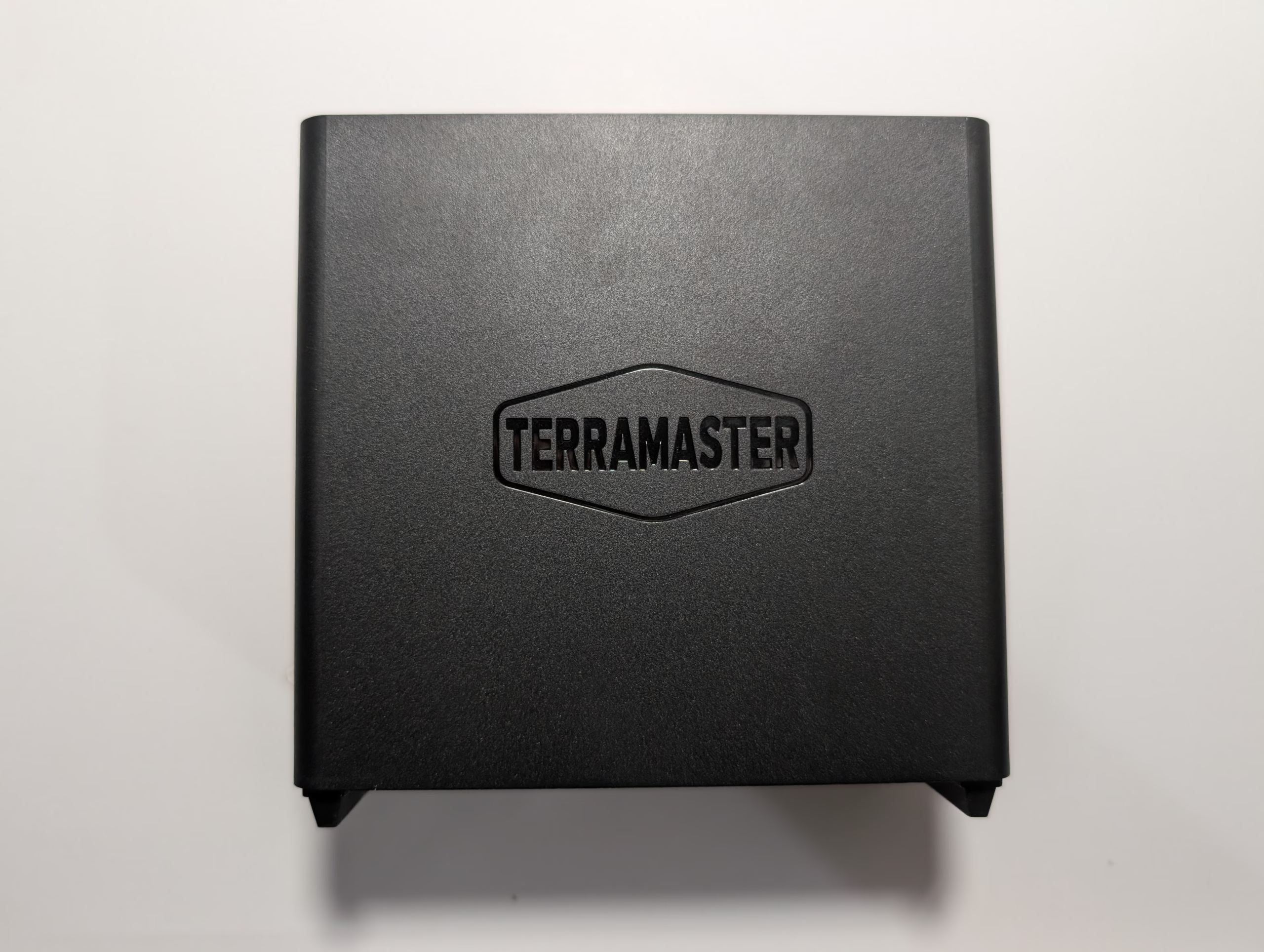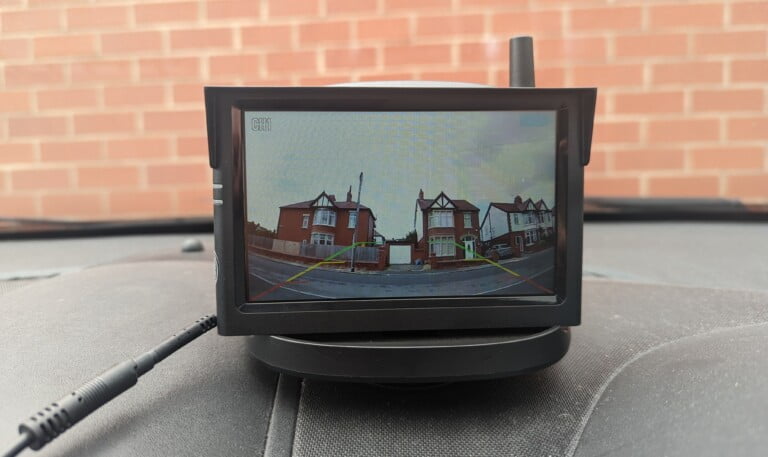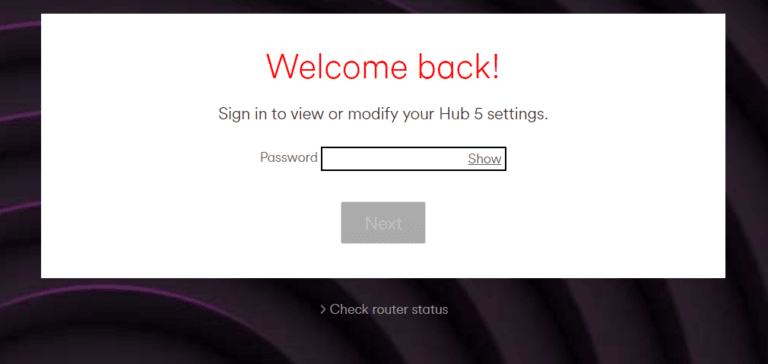Any links to online stores should be assumed to be affiliates. The company or PR agency provides all or most review samples. They have no control over my content, and I provide my honest opinion.
The TerraMaster D4 SSD is a compact direct-attached storage (DAS) device offering high-speed connectivity via USB4 and support for four M.2 NVMe drives. Designed to appeal to content creators, professionals working with large media files, and power users seeking flexible, fast external storage, this enclosure allows up to 32TB of raw capacity using four 8TB drives. Unlike traditional 3.5” or 2.5” drive enclosures, the D4 SSD leverages the speed and compactness of PCIe-based NVMe SSDs, with performance figures that can rival internal storage setups when used optimally.
While this is not particularly cheap, it is clearly targeted at users requiring high-performance external storage who are likely willing to pay for premium-priced products.
| Preview | Product | Rating | Price | |
|---|---|---|---|---|

| TERRAMASTER D4 SSD NVMe Enclosure - 4bay USB4 40Gbps Type-C,... |
£279.99 | Buy on Amazon |
Related Reviews
Specification
| Specification | TerraMaster D4 SSD |
| Storage | |
| Disk Slot Number | 4 |
| Compatible Disk Types | PCIe NVMe M.2 2280 SSD |
| File System | NTFS, APFS, Mac OS, FAT32, EXT4, exFAT |
| Maximum Internal Raw Capacity | 32 TB (8TB SSD * 4) |
| RAIDs Supported | SINGLE DISK |
| USB | USB4 40Gbps |
| Reading/writing Speed (max.) | |
| Reading Speed (max.) | 3257 MB/s (Samsung 990 Pro 4TB*4_RAID0); 1600MB/s (Samsung 990 Pro 4TB*1) |
| Writing Speed (max.) | 3192 MB/s (Samsung 990 Pro 4TB*4_RAID0); 1500MB/s (Samsung 990 Pro 4TB*1) |
| Appearance | |
| Size (H*W*D) | 138 x 60 x 140 mm |
| Packaging Size (H*W*D) | 185 x 172 x 152 mm |
| Weight | net weight: 392g, Gross Weight: 891g |
| Others | |
| System fan | 50 x 50 x 10mm 2PCS |
| Fan mode | Smart |
| Noise Level | 19.0 dB(A) (Using M.2 SSDs in standby mode; Test environment noise: 17.3dB(A); Test distance: 1m) |
| Power Supply | |
| Power Supply | 24 W |
| AC Input Voltage | 100V to 240V AC |
| Current Frequency | 50/60 Hz, Single Phase |
| Power Consumption | 15.0 W (Fully loaded Seagate 2TB M.2 SSDs in read/write state) |
| 6.0 W (Fully loaded Seagate 2TB M.2 SSDs in hibernation) | |
| Other | |
| Supported OS | Mac OS、Windows 11(24H2 or later version) |
| Warranty | 2 years |
| Package Contents: | Host unit (x1) |
| USB4 Cable C to C 0.8m (x1) | |
| Quick Installation Guide (x1) | |
| Power adapter (x1) | |
| Screws (several) | |
| Limited Warranty Note (x1) |
Unboxing / Design
The TerraMaster D4 SSD arrives in basic packaging like all TerraMaster products and contains the essentials: the enclosure itself, a USB-C to USB-C cable measuring 0.8 metres, a power adapter, installation screws, and basic documentation.
The front panel remains completely clean except for a small D4 SSD label, with ventilation grilles covering the top surface. The rear houses the USB4 port, power input, and a single thumb screw for accessing the interior.
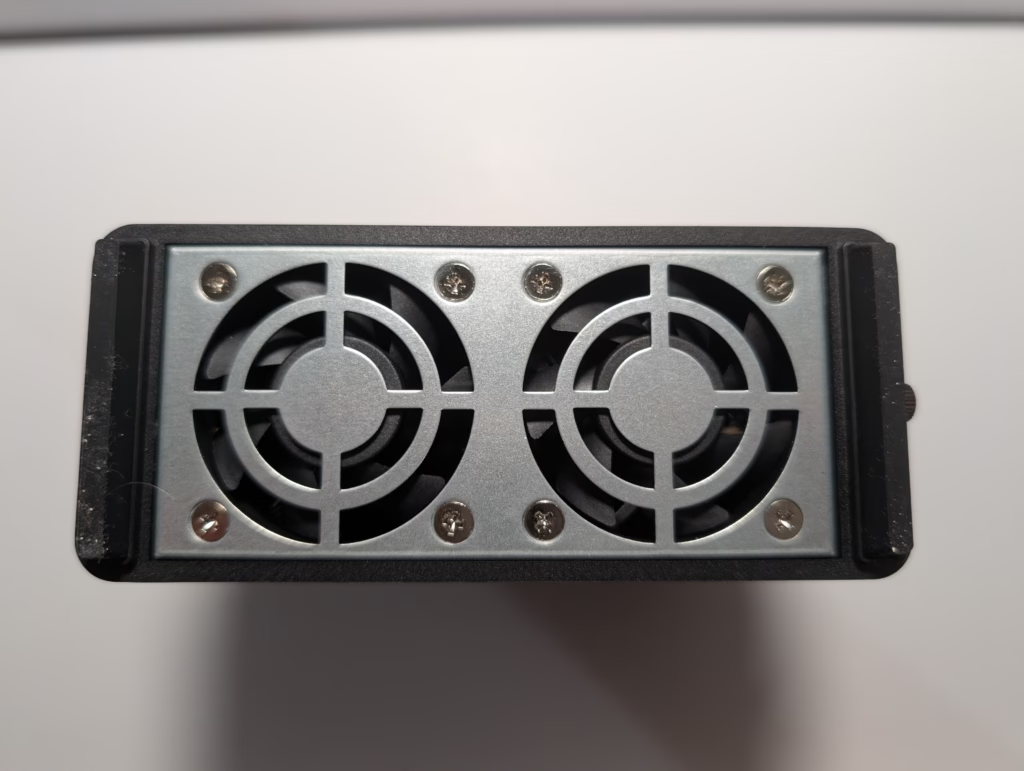
Without using this device, my main criticism would be the use of a DC barrel port for power. The power supply is only 24W, and the spec sheet says the typical power consumption of a fully populated enclosure is just 15W. It seems stupid not to allow this to be powered via USB. Ideally, a 2nd USB-C port specifically for power (in case your PC/laptop can’t supply enough power) or, at the very least, allow you to drive the enclosure via the single USB-C port and then the barrel port for devices that can’t provide enough power.
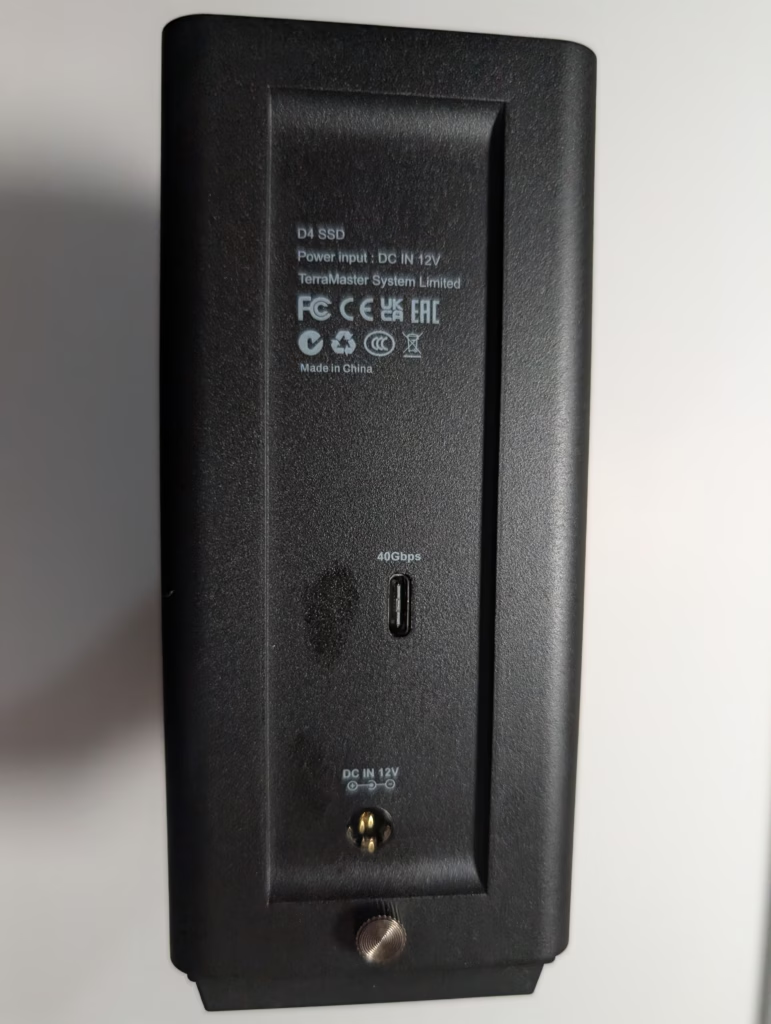
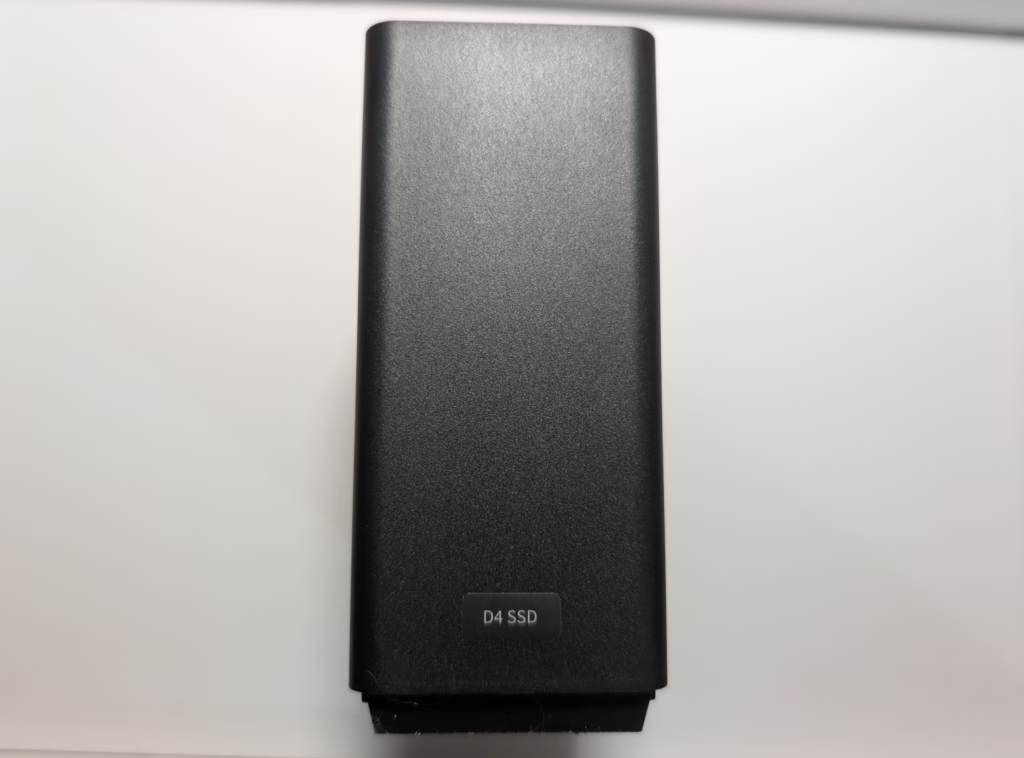
Set Up / Installation
As far as setting this up goes, it couldn’t be simpler. The enclosure has a thumb screw to release the housing, and TerraMaster includes a small screwdriver for the M.2 retaining screws.
The M.2 installation process follows standard procedures: remove the mounting screw, insert the drive at an angle, press down, and secure with the screw. The enclosure accommodates only 2280-format drives, which covers the vast majority of consumer NVMe SSDs. Additional mounting points suggest compatibility with shorter drives, though 2280 remains the standard.
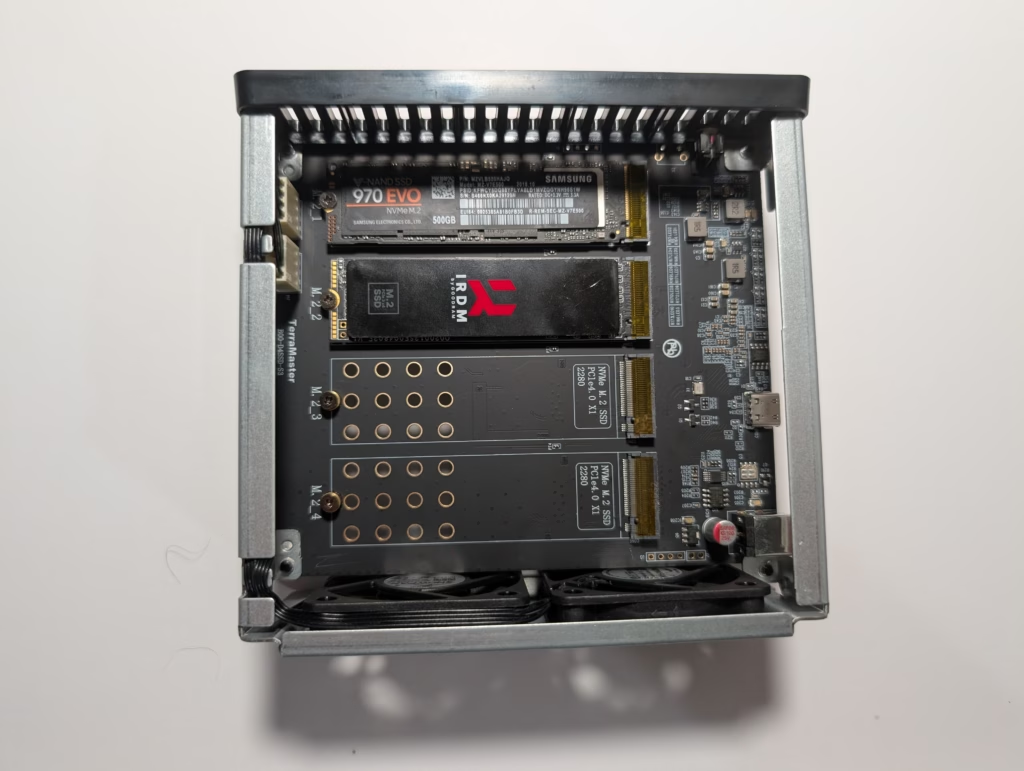
Unlike some of the TerraMaster enclosures, this one lacks any built-in RAID functionality. So, the drives will be picked up separately.
Windows users can create striped or spanned volumes through Disk Management, effectively providing RAID 0 or JBOD functionality. macOS users can achieve similar results through Disk Utility’s RAID assistant. An alternative RAID solution is SoftRAID from OWC.
An alternative way to use this enclosure is with a TerraMaster NAS where it is possible to create full storage pools in TOS 6 connected over USB, however I have not tested this.
Performance
One of the appealing things about this enclosure is that I can use old NVMe drives I have lying around for additional fast backup storage. For my initial testing, I used an old 1TB Samsung NVMe SSD and a Goodram 1TB IRDM M.2 NVMe SSD. Considering this enclosure costs £280 and NVMe drives are relatively inexpensive nowadays, this is probably not the most cost-efficient way to use old drives.
The ASMedia ASM2464PDX controller provides the foundation for the D4 SSD’s performance, offering PCIe 4.0 x1 connectivity to each M.2 slot. This configuration provides a theoretical maximum of 2GB/s per slot, though real-world performance depends heavily on the installed SSDs and configuration chosen.
Initial testing with the Samsung 1TB NVMe SSD achieved read speeds of 903MB/s and write speeds of 872MB/s when connected to a 10Gbps USB port. Moving to a USB4-equipped laptop dramatically improved results, with single drive performance reaching 1567MB/s read speeds.
The performance transformation becomes more apparent when using multiple drives in a striped configuration. Testing with two drives achieved combined speeds of 3002MB/s, approaching the theoretical maximum for the USB4 interface. This represents excellent utilisation of available bandwidth and demonstrates the enclosure’s ability to aggregate individual drive performance effectively.
Temperature management proves adequate during extended testing, with the dual fans maintaining reasonable operating temperatures even under sustained load. The fans operate quietly enough to avoid distraction in typical office environments, under light load, I had to place my ear next to the air vents to hear it properly, my desktop PC fans easily drowned out the noise from this enclosure. Under heavy load, they may become more noticeable.
Real-world file transfer testing revealed consistent performance across different scenarios. Large file copies maintained steady transfer rates, whilst mixed workloads showed the expected variability. The USB4 interface proved stable throughout testing, with no connection drops or stability issues encountered.
Software and Compatibility
The D4 SSD’s software-agnostic approach proves both a strength and limitation. By avoiding proprietary RAID implementations, it maintains broad compatibility across different operating systems and use cases. Windows users can leverage built-in Disk Management tools for basic RAID functionality, whilst macOS users have similar capabilities through Disk Utility.
However, this approach also means missing some conveniences found in more integrated solutions. There’s no dedicated management software for monitoring drive health, performance metrics, or thermal conditions. Users must rely on third-party tools or operating system utilities for such information.
TerraMaster does provide TPC Backupper software, though this proves to be a rebranded version of AOMEI Backupper with persistent upgrade prompts. The backup functionality works adequately but lacks the polish expected from a premium storage solution. The software’s web-based activation process and subsequent upselling attempts feel unnecessarily commercial.
Price and Alternative Options
| Preview | Product | Rating | Price | |
|---|---|---|---|---|

| TERRAMASTER D4 SSD NVMe Enclosure - 4bay USB4 40Gbps Type-C,... |
£279.99 | Buy on Amazon |
The TerraMaster D4 SSD has an RRP of £280
They also have the D1 SSD Plus, which is a single drive USB4 40Gbps enclosure for £110
There is also the D5 and D8 Hybrid, which combine 3.5” drives with NVMe. The D5 is 2+3 for £210 while the D8 is 2+6 for £300. The downside is that these are limited to USB 3.2 Gen 2 10Gbps Type C.
Single-drive USB4 enclosures typically have an RRP from around £100, though some random brands on Amazon have them for as low as £60.
Competing options seem to be limited to Thunderbolt 3. In theory, you may be able to achieve the full throughput with USB4, as this is based on the TB3 spec, but it is dependent on whether the USB4 port supports TB3.
OWC has the Express 4M2, which is available for around £220 without a licence for SoftRaid or £330 with a licence. This is TB3 and has the advantage of dual TB3 ports for daisy chaining and a DisplayPort
StarTech.com has a 4 Bay Thunderbolt 3 (40Gbps) NVMe Enclosure priced at £350
Overall
The TerraMaster D4 SSD is a excellent and well-built enclosure designed for users who need fast, portable, multi-drive storage and who have systems capable of utilising USB4 to its full potential. Its modular design, passive and active cooling, and straightforward setup process make it easy to recommend for professionals handling large media files or managing multiple project drives.
While I feel like the £280 is a bit expensive, there is not really anything competing with this directly, and competing TB3 based enclosures are at a similar price point.
However, the decision to require external power limits portability unnecessarily, particularly given the modest power requirements. The lack of hardware RAID functionality restricts compatibility with third-party NAS devices.
If you’re looking for a multi-bay NVMe enclosure and already own several spare drives — or want the flexibility to swap them out regularly — the TerraMaster D4 SSD performs well and remains one of the few USB4 enclosures in this category.
TerraMaster D4 SSD review – 4 Bay NVMe USB4 Enclosure
Summary
The TerraMaster D4 SSD represents a well-engineered solution for users requiring high-performance external storage, particularly those working with large media files or managing multiple project drives. Its USB4 connectivity and four-bay NVMe configuration deliver impressive throughput figures, with striped configurations achieving speeds that approach internal storage performance.
Overall
80%-
Overall - 80%80%
Pros
Excellent Performance: Supports up to ~3200 MB/s read/write in RAID 0 configurations using USB4.
USB4 Compatibility: Allows for much higher bandwidth than typical USB 3.2 Gen 2 enclosures.
High Capacity: Supports up to 32TB using four 8TB NVMe drives.
Cons
Requires External Power: Despite modest power requirements, it uses a 24W barrel plug adapter instead of allowing USB-C power delivery.
No Hardware RAID: Relies entirely on OS-based or third-party RAID, which may reduce compatibility with some NAS or storage solutions.
I am James, a UK-based tech enthusiast and the Editor and Owner of Mighty Gadget, which I’ve proudly run since 2007. Passionate about all things technology, my expertise spans from computers and networking to mobile, wearables, and smart home devices.
As a fitness fanatic who loves running and cycling, I also have a keen interest in fitness-related technology, and I take every opportunity to cover this niche on my blog. My diverse interests allow me to bring a unique perspective to tech blogging, merging lifestyle, fitness, and the latest tech trends.
In my academic pursuits, I earned a BSc in Information Systems Design from UCLAN, before advancing my learning with a Master’s Degree in Computing. This advanced study also included Cisco CCNA accreditation, further demonstrating my commitment to understanding and staying ahead of the technology curve.
I’m proud to share that Vuelio has consistently ranked Mighty Gadget as one of the top technology blogs in the UK. With my dedication to technology and drive to share my insights, I aim to continue providing my readers with engaging and informative content.
Last update on 2025-10-07 / Affiliate links / Images from Amazon Product Advertising API

